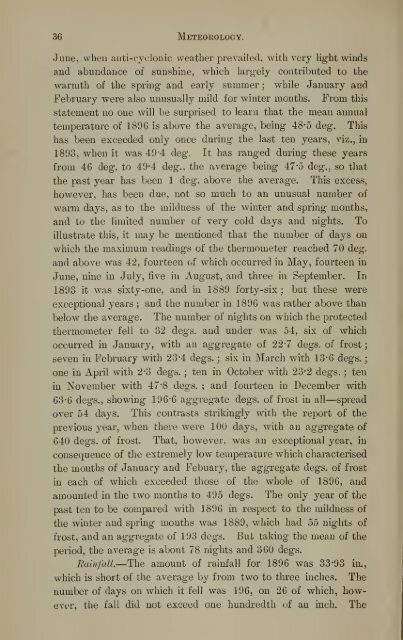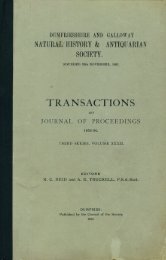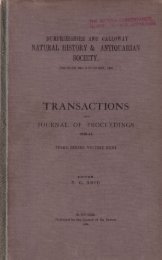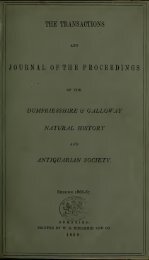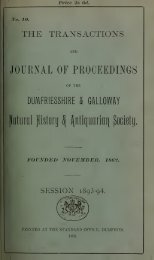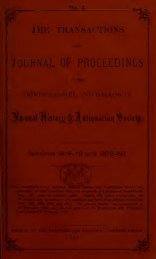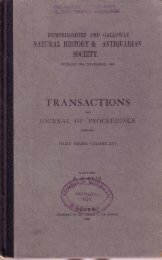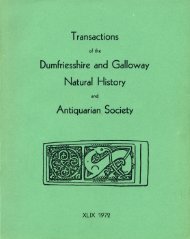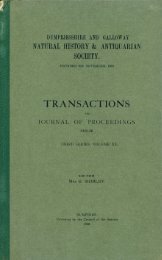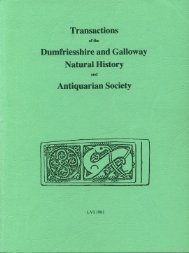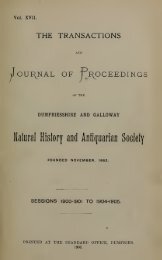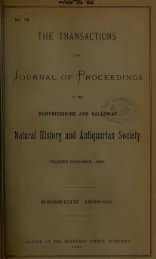Vol 13 - Dumfriesshire & Galloway Natural History and Antiquarian ...
Vol 13 - Dumfriesshire & Galloway Natural History and Antiquarian ...
Vol 13 - Dumfriesshire & Galloway Natural History and Antiquarian ...
You also want an ePaper? Increase the reach of your titles
YUMPU automatically turns print PDFs into web optimized ePapers that Google loves.
36 Meteorology.<br />
June, when auti-cj^clonic weather prevailed, with very lig'ht winds<br />
<strong>and</strong> abundance of sunshine, which largely contributed to the<br />
warmth of the spring <strong>and</strong> early summer ; while January <strong>and</strong><br />
February were also unusually mild for winter months. From this<br />
statement no one will be surprised to learn that the mean annual<br />
temperature of 1896 is above the average, being 48-5 deg. This<br />
has been exceeded only once during the last ten years, viz., in<br />
1893, when it was 49'4 deg. It has ranged during these years<br />
from 46 deg. to 49-4 deg., the average being 47*5 deg., so that<br />
the past year has been 1 deg. above the average. This excess,<br />
however, has been due, not so much to an unusual number of<br />
warm days, as to the mildness uf the winter <strong>and</strong> spring months,<br />
<strong>and</strong> to the limited number of very cold days <strong>and</strong> nights. To<br />
illustrate this, it may be mentioned that the number of days on<br />
which the maximum readings of the thermometer reached 70 deg.<br />
<strong>and</strong> above was 42, fourteen of which occurred in May, fourteen in<br />
June, nine in July, five in August, <strong>and</strong> three in September. In<br />
1893 it was sixty-one, <strong>and</strong> in 1889 forty-six ; but these were<br />
exceptional years ;<br />
<strong>and</strong> the number in 1896 was i-ather above than<br />
below the average. The number of nights on which the protected<br />
thermometer fell to 32 degs. <strong>and</strong> under was 54, six of which<br />
occurred in January, with an aggregate of 227 degs. of frost<br />
seven in February with 23-4 degs. ; six in March with <strong>13</strong>-G degs.<br />
one in April with 2-3 degs. ; ten in October with 23-2 degs. ; ten<br />
in November with 47*8 degs. ; <strong>and</strong> fourteen in December with<br />
63"6 degs., showing 196*6 aggregate degs. of frost in all—spread<br />
over 54 days. This contrasts strikingly with the report of the<br />
previous year, when there were 100 days, with an aggregate of<br />
640 degs. of frost. That, however, was an exceptional year, in<br />
consequence of the extremely low temperature which characterised<br />
the months of January <strong>and</strong> Febuary, the aggregate degs. of frost<br />
in each of which exceeded those of the whole of 1896, <strong>and</strong><br />
amounted in the two months to 495 degs. The only year of the<br />
past ten to be compared with 1896 in respect to the mildness of<br />
the winter <strong>and</strong> spring months was 1889, which had 55 nig-hts of<br />
frost, <strong>and</strong> an aggregate of 193 degs. But taking the mean of the<br />
period, the average is about 78 nights <strong>and</strong> 360 degs.<br />
Rainfall.—The amount of rainfall for 1896 was 33-93 in.,<br />
which is short of the average by from two to three inches. The<br />
number of days on which it fell was 196, on 26 of which, however,<br />
the fall did not exceed one hundredth of an inch. The<br />
;


